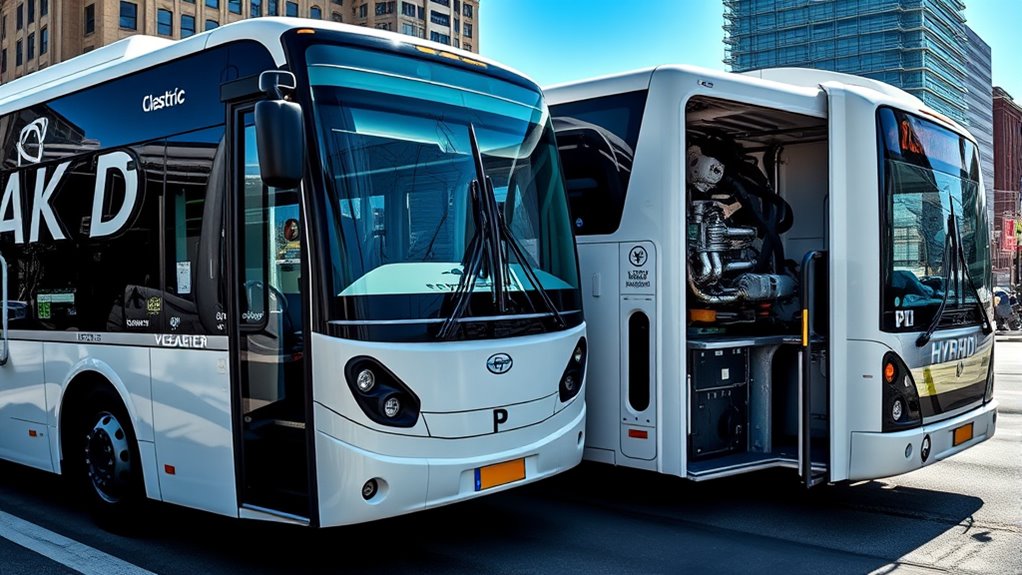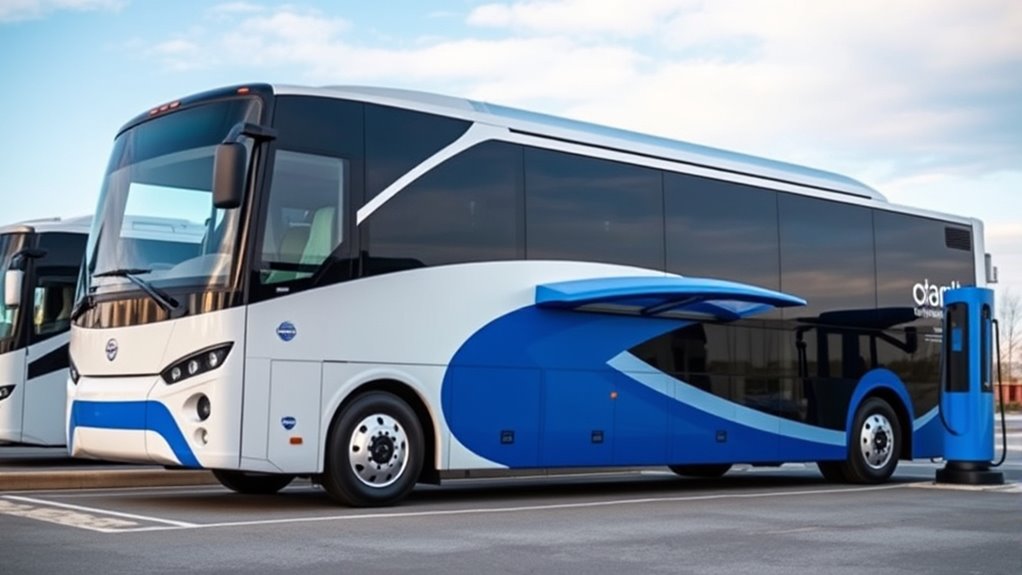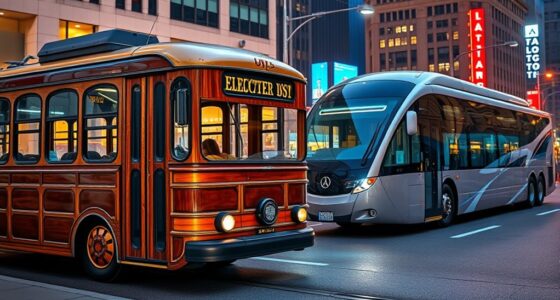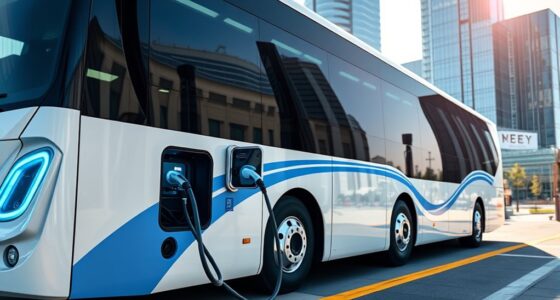Electric buses run solely on rechargeable batteries, producing no tailpipe emissions, while hybrid buses combine a traditional engine with electric motors, switching modes based on driving conditions. This fundamental difference affects their environmental impact, operational costs, and infrastructure requirements. Electric buses are quieter and have lower maintenance, but need charging stations, whereas hybrids offer flexibility with both engine and electric power. To understand how these differences influence your transportation choices, keep exploring their features and benefits.
Key Takeaways
- Electric buses run solely on rechargeable batteries, producing zero tailpipe emissions, while hybrids combine an internal combustion engine with electric power.
- Electric buses require charging stations and have limited range based on battery capacity, unlike hybrids that can switch between electric and fuel modes.
- Electric buses tend to be more expensive initially but offer greater fuel savings, whereas hybrids are less costly upfront with moderate emission reductions.
- Electric buses have fewer moving parts, resulting in lower maintenance needs compared to hybrids which maintain both engine and electric systems.
- The environmental benefits of electric buses depend heavily on renewable energy sources for electricity, whereas hybrids still emit some pollutants through combustion.

Electric and hybrid buses are increasingly popular options for cleaner transportation, but they differ markedly in how they operate and impact the environment. If you’re considering which type to choose, understanding these differences helps you make an informed decision.
Electric buses depend solely on rechargeable battery packs for propulsion. They operate in a zero-emission electric mode, which means no tailpipe emissions at all. These buses require plug-in charging stations, and their range is limited by battery capacity. When batteries run low, they need to be recharged, usually overnight or during designated stops. Their energy comes entirely from electricity, making their environmental impact highly dependent on how that electricity is generated. If the grid relies on renewable sources, electric buses can notably reduce your carbon footprint.
Electric buses produce no tailpipe emissions; their environmental benefit depends on renewable electricity sources.
Hybrid buses, on the other hand, combine internal combustion engines—typically diesel or gas—with electric motors and batteries. They can operate in multiple modes, switching between electric-only and hybrid modes depending on route length and driving conditions. For short trips or city stops, hybrids can run in electric-only mode, producing no emissions during those segments. For longer routes, the internal combustion engine kicks in, providing continuous power.
Hybrids usually include series and parallel configurations. Series hybrids have the engine act as a generator, charging the batteries, but never directly power the wheels. Parallel hybrids, however, use both the engine and electric motor simultaneously to drive the transmission, sharing the load based on speed and demand. Hybrids recover kinetic energy during braking through regenerative systems, capturing 20-35% of braking energy, which helps reduce fuel consumption and emissions.
From an environmental perspective, electric buses produce no tailpipe emissions, making them the cleaner choice overall. Hybrids cut emissions substantially compared to traditional diesel buses but still emit some pollutants since the internal combustion engine remains part of their system. Both types are quieter than diesel buses, especially at low speeds, thanks to their electric motors. Their energy recovery systems also contribute to efficiency, with hybrids recapturing a notable portion of braking energy.
Cost-wise, electric buses tend to be more expensive upfront, roughly double the cost of diesel buses, due to their batteries and charging infrastructure. Hybrids are about 60% more costly than diesel models. However, electric buses save about 40% on fuel costs, while hybrids save around 15%. Batteries in both types generally last 6-8 years, requiring replacement, which is a significant expense.
Maintenance needs differ: hybrids require both engine and electric system upkeep, whereas electric buses have fewer moving parts and less routine maintenance. These operational and environmental differences make each type suitable for different use cases, whether prioritizing zero emissions or balancing initial costs with fuel savings.
Frequently Asked Questions
What Is the Average Lifespan of Electric Versus Hybrid Buses?
You might wonder about the lifespan of electric versus hybrid buses. Typically, both last around 12 to 15 years.
Electric buses are durable, with batteries designed to last their entire lifespan if maintained properly.
Hybrid buses also reach similar ages but may need battery replacements or more maintenance due to their combined electric and internal combustion systems.
Proper upkeep and operating conditions influence how long each bus type stays in service.
How Do Maintenance Costs Compare Between Electric and Hybrid Buses?
When it comes to maintenance costs, you’ll find electric buses are a real money saver. They’ve fewer moving parts, so there’s less to break down and repair, and no fluid changes or fuel system upkeep.
Hybrid buses still need to maintain both electric and combustion systems, which adds to costs.
Are Electric Buses Suitable for Long-Distance Routes?
You might wonder if electric buses work for long-distance routes. Today’s batteries can cover up to 340 miles, enough for most suburban and urban routes, especially with fast chargers during midday.
Larger batteries and improved tech are extending ranges further. However, for very long routes, you’ll need to plan for charging stops or consider hybrid options.
With proper infrastructure, electric buses can effectively handle many long-distance applications.
What Are the Initial Purchase Price Differences?
You’ll notice that electric buses typically cost between $750,000 and $988,311 upfront, making them more expensive than hybrid buses, which usually range from $450,000 to $550,000.
While both options have higher initial costs compared to diesel buses, electric buses’ advanced technology and battery systems drive their higher price.
Keep in mind, incentives and subsidies can help offset these costs, making them more affordable over time.
How Do Charging and Fueling Times Impact Bus Operation Schedules?
Charging and fueling times directly impact your bus operation schedules. Longer charging sessions, like standard 100 kW chargers taking 4 hours, can delay departures if not properly managed.
High-power chargers reduce wait times but require strategic scheduling during off-peak hours to avoid overloads and high costs. You need to plan charging windows carefully, balancing operational needs with cost savings and infrastructure capacity to guarantee timely, reliable service.
Conclusion
Imagine gliding silently through city streets, your electric bus humming like a calm, clean breeze, leaving behind only fresh air and quiet. Unlike hybrid buses that still carry the faint hum of an engine, electric buses offer a near-silent, eco-friendly journey. As you ride, you become part of a cleaner, greener future, where streets sparkle with hope and each stop is a step toward a healthier planet. Choose electric, and feel the difference in every peaceful mile.









